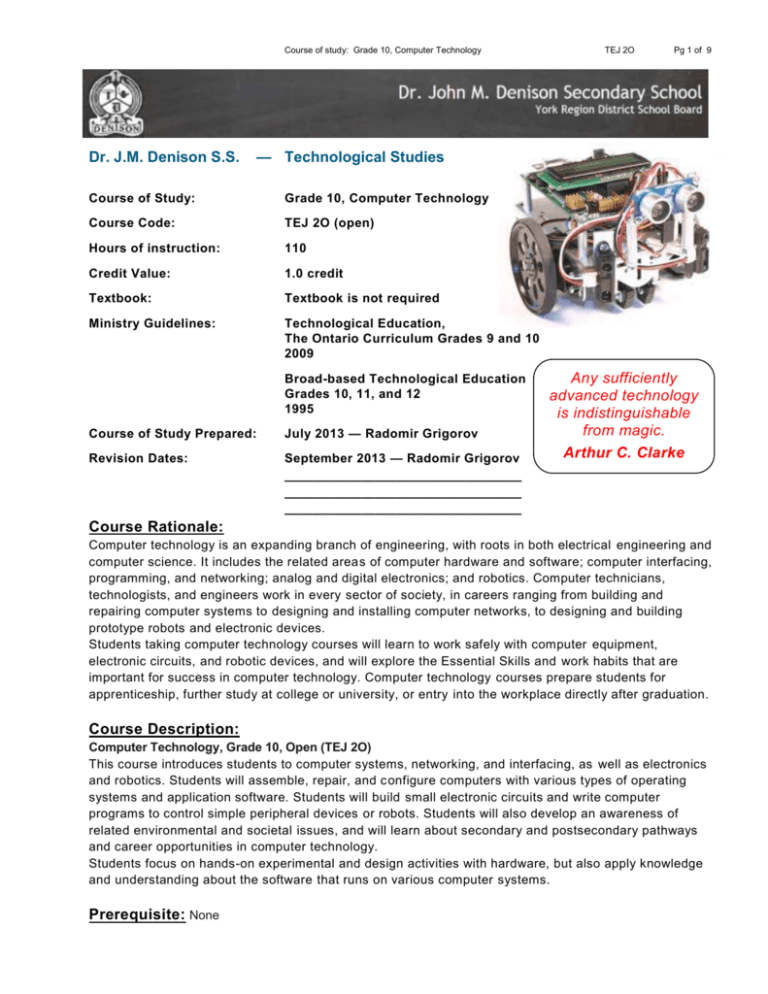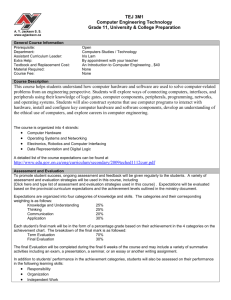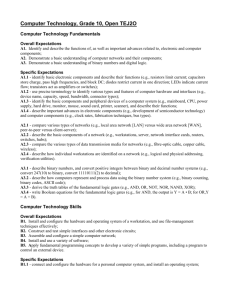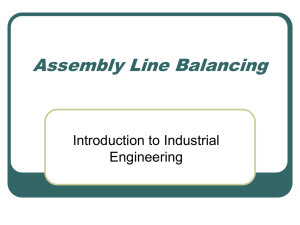Course of Study TEJ2O
advertisement

Course of study: Grade 10, Computer Technology Dr. J.M. Denison S.S. TEJ 2O Pg 1 of 9 — Technological Studies Course of Study: Grade 10, Computer Technology Course Code: TEJ 2O (open) Hours of instruction: 110 Credit Value: 1.0 credit Textbook: Textbook is not required Ministry Guidelines: Technological Education, The Ontario Curriculum Grades 9 and 10 2009 Broad-based Technological Education Grades 10, 11, and 12 1995 Course of Study Prepared: July 2013 — Radomir Grigorov Revision Dates: September 2013 — Radomir Grigorov __________________________________ __________________________________ __________________________________ Any sufficiently advanced technology is indistinguishable from magic. Arthur C. Clarke Course Rationale: Computer technology is an expanding branch of engineering, with roots in both electrical engineering and computer science. It includes the related areas of computer hardware and software; computer interfacing, programming, and networking; analog and digital electronics; and robotics. Computer technicians, technologists, and engineers work in every sector of society, in careers ranging from building and repairing computer systems to designing and installing computer networks, to designing and building prototype robots and electronic devices. Students taking computer technology courses will learn to work safely with computer equipment, electronic circuits, and robotic devices, and will explore the Essential Skills and work habits that are important for success in computer technology. Computer technology courses prepare students for apprenticeship, further study at college or university, or entry into the workplace directly after graduation. Course Description: Computer Technology, Grade 10, Open (TEJ 2O) This course introduces students to computer systems, networking, and interfacing, as well as electronics and robotics. Students will assemble, repair, and c onfigure computers with various types of operating systems and application software. Students will build small electronic circuits and write computer programs to control simple peripheral devices or robots. Students will also develop an awareness of related environmental and societal issues, and will learn about secondary and postsecondary pathways and career opportunities in computer technology. Students focus on hands-on experimental and design activities with hardware, but also apply knowledge and understanding about the software that runs on various computer systems. Prerequisite: None Course of study: Grade 10, Computer Technology TEJ 2O Pg 2 of 9 Course Expectations A. COMPUTER TECHNOLOGY FUNDAMENTALS OVERALL EXPECTATIONS By the end of this course, students will: A1. Identify and describe the functions of, as well as important advances related to, electronic and computer components; A2. Demonstrate a basic understanding of computer networks and their components; A3. Demonstrate a basic understanding of binary numbers and digital logic. SPECIFIC EXPECTATIONS A1. Computer Hardware By the end of this course, students will: A1.1 identify basic electronic components and describe their functions (e.g., resistors limit current; capacitors store charge, pass high frequencies, and block DC; diodes restrict current in one direction; LEDs indicate current flow; transistors act as amplifiers or switches); A1.2 use precise terminology to identify various types and features of computer hardware and interfaces (e.g., device name, capacity, speed, bandwidth, connector types); A1.3 identify the basic components and peripheral devices of a computer system (e.g., mainboard, CPU, power supply, hard drive, monitor, mouse, sound card, printer, scanner), and describe their functions; A1.4 describe important advances in electronic components (e.g., development of semiconductor technology) and computer components (e.g., clock rates, fabrication techniques, bus types). A2. Networking Concepts By the end of this course, students will: A2.1 compare various types of networks (e.g., local area network [LAN] versus wide area network [WAN], peerto-peer versus client-server); A2.2 describe the basic components of a network (e.g., workstations, server, network interface cards, routers, switches, hubs); A2.3 compare the various types of data transmission media for networks (e.g., fibre-optic cable, copper cable, wireless); A2.4 describe how individual workstations are identified on a network (e.g., logical and physical addressing, verification utilities). A3. Data Representation And Digital Logic By the end of this course, students will: A3.1 describe binary numbers, and convert positive integers between binary and decimal number systems (e.g., convert 24710 to binary, convert 111101112 to decimal); A3.2 describe how computers represent and process data using the binary number system (e.g., binary counting, binary codes, ASCII code); A3.3 derive the truth tables of the fundamental logic gates (e.g., AND, OR, NOT, NOR, NAND, XOR); A3.4 write Boolean equations for the fundamental logic gates (e.g., for AND, the output is Y = A • B; for OR,Y = A + B). Course of study: Grade 10, Computer Technology B. TEJ 2O Pg 3 of 9 Computer Technology Skills OVERALL EXPECTATIONS By the end of this course, students will: B1. Install and configure the hardware and operating system of a workstation, and use file-management techniques effectively; B2. Construct and test simple interfaces and other electronic circuits; B3. Assemble and configure a simple computer network; B4. Install and use a variety of software; B5. Apply fundamental programming concepts to develop a variety of simple programs, including a program to control an external device. SPECIFIC EXPECTATIONS B1. Workstation Setup By the end of this course, students will: B1.1 connect and configure the hardware for a personal computer system, and install an operating system; B1.2 describe the hardware requirements of operating systems (e.g., processor speed and bus width, available storage space, memory size and speed); B1.3 use file-management techniques to organize and back up files efficiently (e.g., move and rename files, store files on a network drive, use file-management and backup software). B2. Electronics, Robotics and Computer Interfacing By the end of this course, students will: B2.1 safely construct and test electronic circuits (e.g., LED circuit, flasher, timer), using both breadboard and soldering techniques to connect discrete components and/or integrated circuits; B2.2 use appropriate procedures to prevent damage to computer hardware and electronic components (e.g., use anti-static wrist strap and grounding mat when handling sensitive components; avoid overheating solidstate devices when soldering); B2.3 describe and build an interface to connect a computer to a simple peripheral or robotic device (e.g., LED traffic light, DC motor, robotic arm); B2.4 trace the operation of a system consisting of a computer, a program, an interface, and external hardware to ensure that the interface circuit functions properly; B2.5 use appropriate test equipment to measure electrical quantities (e.g., voltage, resistance). B3. Network Setup and Management By the end of this course, students will: B3.1 install and configure a peer-to-peer (P2P) network, using appropriate software and connection devices; B3.2 enable network services (e.g., file sharing, print services); B3.3 install and use a network-enabled application or file-sharing scheme (e.g., game, database, peer-to-peer file sharing). Course of study: Grade 10, Computer Technology TEJ 2O Pg 4 of 9 B4. Software By the end of this course, students will: B4.1 describe the differences between operating systems and applications software; B4.2 install and configure software on a workstation (e.g., word-processing suite, driver for new hardware); B4.3 use software support systems to find technical information independently (e.g., help menu, online help, manuals); B4.4 use utility software to perform basic maintenance functions (e.g., defragment a disk drive, undelete a file, determine available space on a storage device, restore a file from a backup). B5. Computer Programming By the end of this course, students will: B5.1 use a procedural programming language to define constants and variables, write expressions and assignment statements, and specify the order in which the operations are performed in a program; B5.2 use input and output statements in a program (e.g., input a name and display it onscreen); B5.3 use a decision structure and a repetition structure in a program (e.g., determine if a user is old enough to drive, run a high-low guessing game, count from a starting value to an end value); B5.4 use a design process (see pp. 18–19) to plan, write, and test a computer program to control a simple robot or peripheral device (e.g., servo motor, LED display). Course of study: Grade 10, Computer Technology C. TEJ 2O Pg 5 of 9 TECHNOLOGY, THE ENVIRONMENT, AND SOCIETY OVERALL EXPECTATIONS By the end of this course, students will: C1. identify harmful effects of the widespread use of computers and associated technologies on the environment, as well as agencies that reduce these effects; C2. identify effects of the widespread use of computers and associated technologies on society. SPECIFIC EXPECTATIONS C1. Technology and the Environment By the end of this course, students will: C1.1 identify harmful effects of computer use on the environment (e.g., resources used and wastes created during production; disposal of old computers in landfill); C1.2 identify government agencies and community partners that provide resources and guidance for environmentally sound production, use, and recycling of computer equipment (e.g., recycling centres that accept old computers and/or batteries, companies that recycle printer cartridges or refurbish computers for resale). C2. Technology and Society By the end of this course, students will: C2.1 identify some of the effects of the development of computer technology on society (e.g., cheaper and faster communication in a “global village”; almost instant access to information; changes in the nature of work; telecommuting; easily accessible means of recording and maintaining knowledge and traditions of minority cultures); C2.2 describe how computers are used in various occupations (e.g., engineering calculations, architectural drawings, customer tracking and business data collection, navigation of airplanes and ships), and what work in these occupations would be like without computers. Course of study: Grade 10, Computer Technology D. TEJ 2O Pg 6 of 9 PROFESSIONAL PRACTICE AND CAREER OPPORTUNITIES OVERALL EXPECTATIONS By the end of this course, students will: D1. follow appropriate health and safety procedures when assembling, using, and maintaining computer systems; D2. demonstrate an understanding of ethical and security issues related to the use of computers; D3. identify various careers related to computer technology, and describe the education and/or training required for them. SPECIFIC EXPECTATIONS D1. Health and Safety By the end of this course, students will: D1.1 use appropriate equipment, procedures, and techniques (e.g., use a wrist support, ensure power is off before opening the case of a computer, use proper lifting techniques when moving heavy equipment) to protect health and ensure safety when working with computers (e.g., to avoid musculoskeletal injuries, eye strain, repetitive strain injuries); D1.2 identify issues related to Internet safety and personal identity security (e.g., protection of information stored on computers or transmitted over a network, identity theft, cyberstalking, cyberbullying, privacy policies). D2. Ethics and Security By the end of this course, students will: D2.1 demonstrate an understanding of the importance of ethical computer use (e.g., the social cost of hacking, lost and corrupt data, and plagiarism); D2.2 comply with acceptable-use policies (e.g., protection of client information; prohibitions on unsolicited bulk mailings, transfers of copyright material, and posting of demeaning comments; safeguarding of passwords). D3. Career Opportunities By the end of this course, students will: D3.1 identify various careers related to computer technology, and determine which ones can be entered directly from secondary school and which ones require college, university, apprenticeship, or other postsecondary training; D3.2 identify sources of information for lifelong learning in the computer field (e.g., trade publications, local colleges, training institutes, seminars, certification programs); D3.3 identify groups and programs that are available to support students who are interested in pursuing nontraditional career choices in computer technology (e.g., mentoring programs, virtual networking/support groups, specialized postsecondary programs, relevant trade/industry associations); D3.4 demonstrate an understanding of the Essential Skills that are important for success in the computer industry, as identified in the Ontario Skills Passport (e.g., reading text, writing, document use, computer use, oral communication, numeracy, thinking skills); D3.5 demonstrate an understanding of the work habits that are important for success in the computer industry, as identified in the Ontario Skills Passport (e.g., working safely, teamwork, reliability, organization, working independently, initiative); D3.6 develop and/or select pieces of work and other materials that provide evidence of their skills and achievements in computer technology, for inclusion in a portfolio (e.g., work logs, skills checklist, flow charts, computer programs, photographs of projects). Course of study: Grade 10, Computer Technology TEJ 2O Pg 7 of 9 Course Organization, Teaching Strategies By the end of this course students will cover most expectations from the curriculum , as shown below, and learn the following: UNIT 1: COMPUTER HARDWARE Inside the box - computer disassembly and assembly Motherboard - major components and functions Input/output ports and devices: HDD, optical disks, flash drives CPU - functions and operation RAM - types and technologies Video Cards and expansion slots UNIT 2: COMPUTER SYSTEMS BIOS - functions and set up Operating System - function and installation Windows utilities: msconfig, task manager, defrag, performance monitor Device drivers - functions and installation Computer system maintenance UNIT 3: NETWORKING Networks - types and configuration Building network patch cables Setting up a small network Remote access and control of computers UNIT 4: DATA REPRESENTATION Numeral systems Digital information - binary code Binary to decimal and decimal to binary conversion Binary math - adding and subtracting UNIT 5: DIGITAL LOGIC Logic gates - functionality and truth tables Fundamental logic gates - integrated circuits; application UNIT 6: ELECTRONICS Circuit theory - Ohm's law Electronic components: resistors, diodes, capacitors, transistors Prototyping with breadboards - building electronic circuits Switching circuits - multivibrator; LED flasher Measurements - multimeter and oscilloscope Soldering - techniques and practical exercises UNIT 7: ROBOTICS AND INTERFACING Parallax's SUMO robots - microcontroller, servo motors, sensors Basic Stamp software - writing small programs for microcontroller Interfacing - controlling an electronic circuit from a PC UNIT 8: INDEPENDENT STUDY UNIT Research specific computer technology application Identify environmental and social impacts A1; A1.2; A1.3; B1; B1.1; D1 B1; B1.1; B1.3; B4; B4.1; B4.4 A2; A2.1; A2.2; B3; B3.1; B3.2 A3; A3.1; A3.2 A3; A3.3; A3.4 A1; A1.1; A1.4; B2; B2.1; B2.2 B2; B2.3; B2.5; B5; B5.2; B5.3 C1; C1.1; C2; C2.1; C2.2; D3 Course of study: Grade 10, Computer Technology TEJ 2O Pg 8 of 9 Assessment and Evaluation Assessment is the ongoing process of collecting information about student achievement for the purpose of student learning. A variety of assessment tools are used. ‘Assessment as learning’ (formative) and ‘assessment for learning’ (diagnostic) do not carry a mark weight. ‘Assessment of learning’ (summative) counts toward the final mark. Seventy percent of the grade is based on evaluations conducted throughout the course; thirty percent will be based on a final evaluation administered towards the end of the course. The evaluation of Learning Skills (responsibility, collaboration, independent work, organization, selfregulation, and initiative) will be reported on with a comment, not a numerical grade. Students will find that concentrating on these skills will result in a higher level of success in meeting the course expectations. Course Evaluation The four achievement categories (Knowledge & Understanding, Thinking & Inquiry, Communication, and Application) will be covered equally throughout course components: Knowledge and Understanding 20.0 % Thinking & Inquiry 20.0 % Communication (including journals) 10.0 % Application 20.0 % Class Work Throughout the Course Total 70.0 % Independent Study Unit 10.0 % Culminating Activity 20.0 % Final Evaluation Total 30.0 % Course Evaluation Total 100.0 % Note: Students who do not complete part or all of the final evaluation may be putting their TEJ2O1 credit in jeopardy. Course Materials & Resources: For the Grade 10 Computer Technology course, students will use the following materials and resources: Materials Various computer parts Various electronic components, including integrated circuits (ICs) Experimental boards and breadboards Printed circuit boards (PCBs) Cables and wires Batteries Resources PC-type computers and modules Windows OS installation software SUMO Robots from Parallax Inc. Interface cables DC adapters Soldering Irons Technological Studies Department Course Polices Course of study: Grade 10, Computer Technology TEJ 2O Pg 9 of 9 Assessment and evaluation of student achievement is based on the Ministry of Education’s curriculum expectations, which are divided into four categories: Knowledge & Understanding; Thinking & Inquiry; Communication; and Application. • The curriculum expectations are listed at the beginning of each chapter in the course text, and serve as a useful checklist for self-evaluation and test preparation. Evaluations based on the four categories (e.g., by rubrics or marking schemes) are funneled into a single, numerical percentage mark (e.g., 76%) for mid-term and final course grades. • The percentage weightings among the four categories (shown on the course outlines) are intended to reflect the ‘destinations’ affixed to each course code: The philosophy that underlies broad-based technological education is that students learn best by doing. This curriculum therefore adopts an activity-based, projectdriven approach that involves students in problem solving as they develop knowledge and skills and gain experience in the technological subject area of their choice. In our University/College destination courses we strive for a balance between theory and practice. Our College and Workplace destination courses have a greater emphasis in the practical orientation of applied work . A variety of assessment tools will be used in the course, including both Assessment as Learning and Assessment of Learning tests and activities. • Assessment for Learning and Assessment as Learning do not carry a mark value, although scores may appear for feedback purposes; they are intended to guide or instruct students, and may be tracked to monitor student progress and work habits. When Self Assessment or Peer Assessment are used, they may only be used as Assessment as Learning (i.e., as feedback) and cannot count toward the course grade. • Assessment of Learning counts towards the final course mark (both the 70% during the course, and the 30% toward the end of the course: the culminating activity and the final exam). • Note: Failure to submit the culminating activity, or to write the final exam, may result in zeroes for these major components of the final mark. The same review may apply in cases of academic dishonesty (plagiarism, cheating, etc.). Although work and study habits (such as lateness & organization), independence, participation and teamwork are not included in the evaluation scheme (these behaviours are now reported separately on the report card, as ‘needs improvement’, ‘satisfactory’, ‘good’ or ‘excellent’), it is expected that students will attend regularly, participate actively, and co-operate on group activities. Where group work is performed, the instructor will award marks based on individual achievement (no group marks). Students must understand that there will be consequences for not completing assignments for evaluation or for submitting those assignments late, in accordance with the Ministry of Education’s “Growing Success” document. It is expected that the work is submitted within the time frame specified by the teacher, unless previously discussed with the teacher. If an insufficient amount of work has been submitted (as determined by the course outline), ‘zeroes’ will be entered in place of ‘incomplete’, and the student’s credit or grade standing may be in jeopardy. Students and their parents/guardians will have partnered in discussion of their progress prior to the potential awarding of a zero






